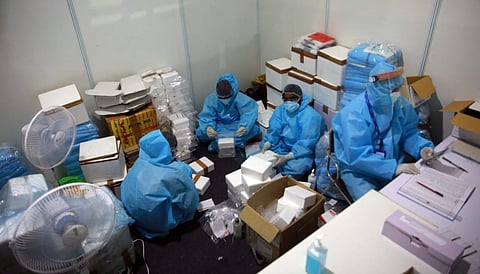

NEW DELHI: All workers in hospitals are more susceptible to Covid-19, but within the category, it's mostly sanitation workers and attendants who are bearing the brunt of the infection, an analysis at the country’s top health institution AIIMS, Delhi has shown.
The study titled “Risk stratification as a tool to rationalize quarantine among health care workers exposed to Covid-19 cases – Evidence from a tertiary healthcare centre in India” showed that a total of 321 positive cases were reported to the Central Contact Tracing Team from April 11 to June 8.
Of these, 238 (74.1%) were healthcare workers and other employees, while 83 (25.9%) were patients admitted in non-Covid areas due to other medical conditions.
Among the Covid positive HCWs, the largest proportion was contributed by hospital attendants and sanitation workers (35.3%), followed by nurses (17.2%), and security personnel (n=32; 13.3%).
Doctors and laboratory staff contributed about 12 % while others included administrative staff (5.5%), and other workers.
These figures tabulated as part of the analysis—as its primary focus was assessing risk for those exposed to confirmed cases—have brought to the fore the extreme vulnerability of the lowest rung workers in hospital settings who are mostly denied basic protection and facilities to avoid the infection.
A researcher associated with the project who did not wish to be named told this newspaper that a main reason for many sanitation workers and ward boys catching the infection could be complete lack of or low-quality personal protection equipment provided to them.
“It’s a fact that they are the most exposed workers in hospitals who are also the most neglected lot,” he said.
Responding to a question on why among the HWCs, the least number of infected were doctors—he cited two reasons.
“One the PPE provided to them is the best quality of late and also senior doctors sometimes only supervise juniors and nurses who tend to the patients directly,” he said.
Though these findings are from only one major tertiary care centre, these could be reflecting the situation in most other large hospitals.
The results assume significance as there is no comprehensive data in the public domain on the impact of the disease in HWCs.
Indian Medical Association, the largest body of private doctors, two days back said that nearly 200 of its members have already succumbed to the infectious disease so far. There is however no clarity on the numbers of other HWCs either in government or private sector.
As the main objective of the study, the AIIMS report meanwhile noted that the 3,853 hospital employees exposed to the 321 Covid-19 cases, both patients as well as other HCWs, were tracked and the as per the risk stratification, 560 contacts were classified as “high risk” and 3,293 (85.5%) as “low risk” contacts.
Of the total 3,853 contacts, 118 (3.1%) tested positive for Covid-19 by RTPCR. Among the 560 high-risk contacts, 40 became Covid-19 positive during the quarantine period.
“The risk stratification tool developed by us served its intended purpose of correctly categorizing the risk category of exposure, as well as minimizing unnecessary quarantine of Covid-19 exposed health care workers,” said the researchers. “The utility of the tool could be further enhanced by some modification in the existing quarantine policy.”